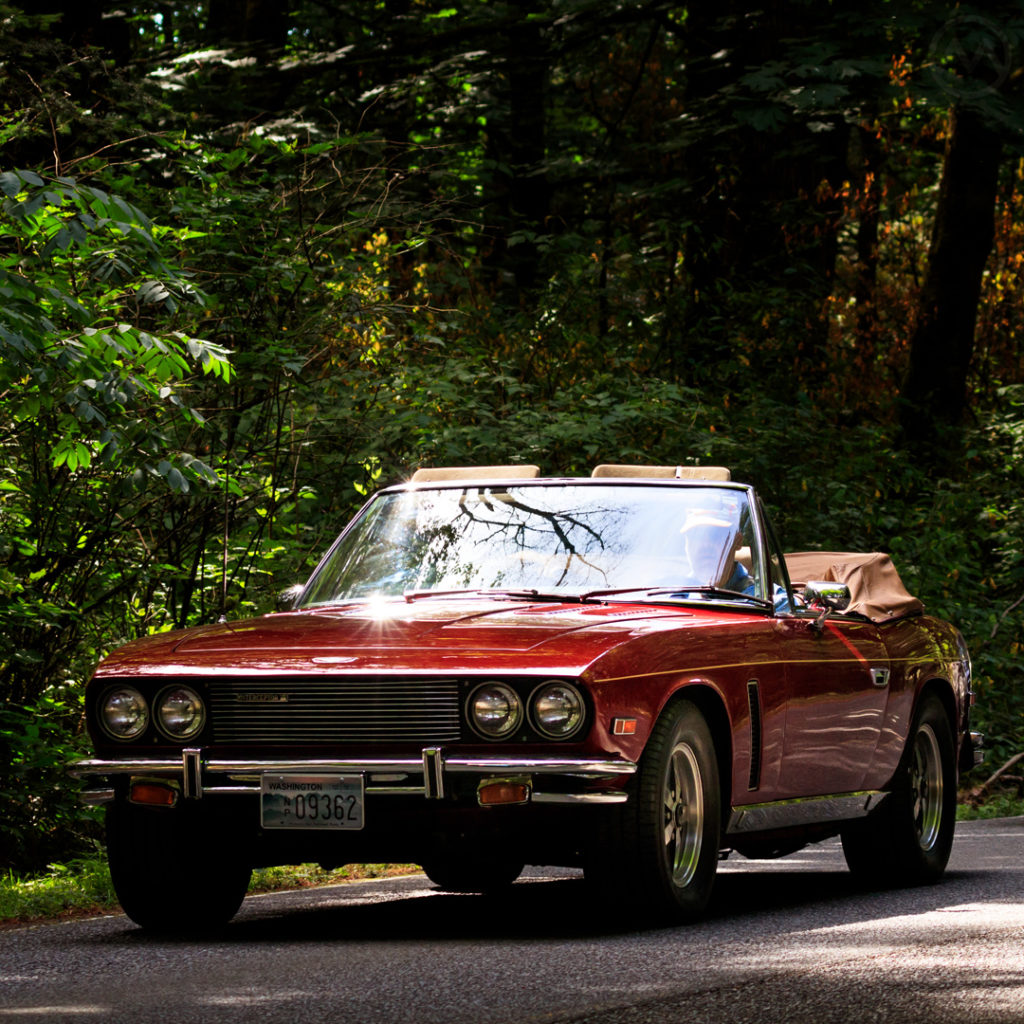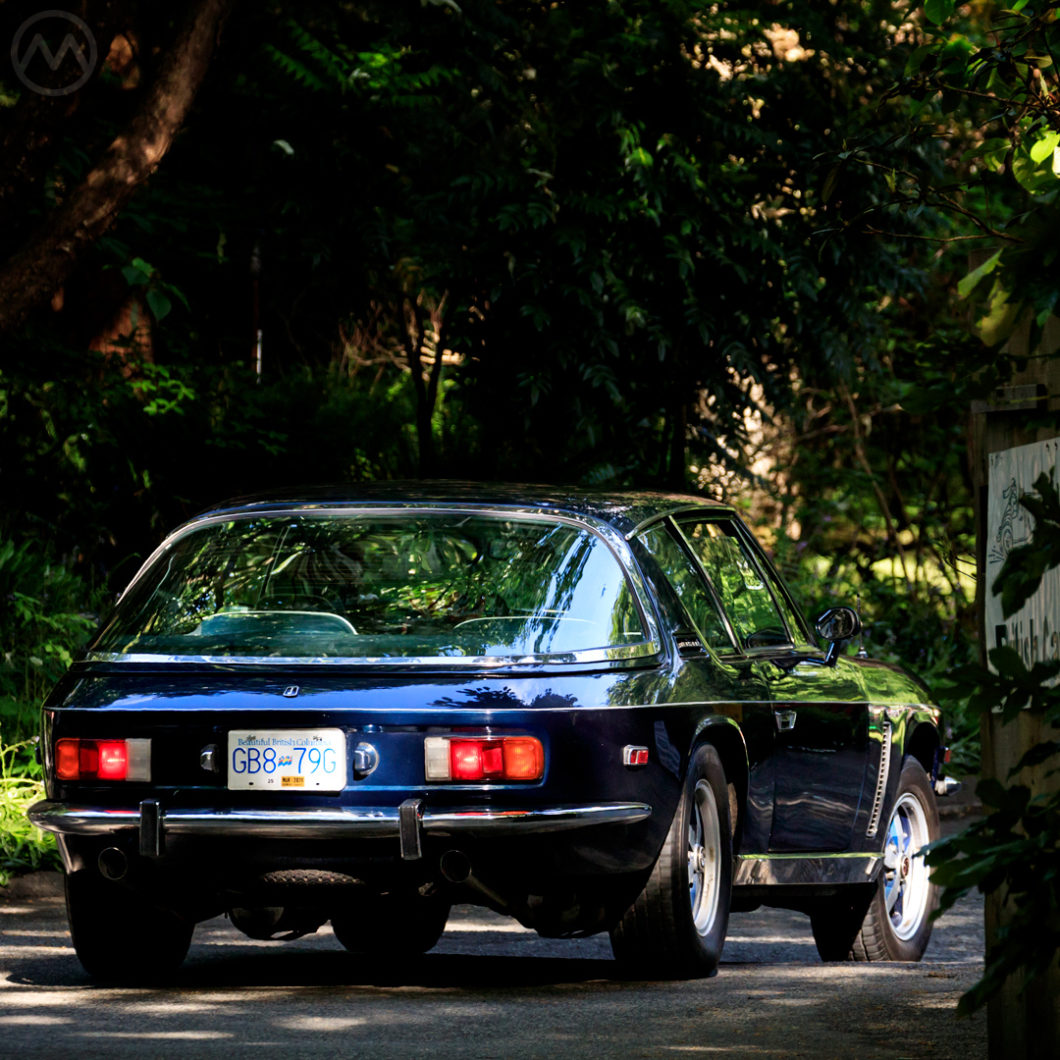That huge glass hatch, that wide look and that V8 burble – it can only be a Jensen Interceptor. Of course, there was more than one interceptor – the name dated back to 1950. But the most famous version is the 1966-76 version.
Ironically the actual Jensen Brothers – Alan and Richard – weren’t much involved with the car that made their name internationally famous, but it’s with them that the story begins.
The brothers had first made a name for themselves styling and building bodies for cars like the Standard Avon and Wolseley Hornet. They’d eventually paired up with a truck body builder, W.J. Smith, where their business flourished as a sideline. The brothers eventually took over that business entirely, building custom cars including on Delage, Ford, Morris, Steyr, and other chassis.
It was one of those Ford specials – a low-slung ‘36 Ford special built for Clark Gable – that got them a meeting with Edsel Ford. From 1937 they were building their own Bentley-esque Ford (and sometimes Lincoln) powered cars in addition to coachbuilding.
Quietly, in the background, they also built truck bodies. There’s rarely a time when trucks aren’t needed. Over the years they also built many bodies for other manufacturers including (but not limited to) the Austin A40 Sports, the Austin-Healey 100, and later, the Volvo 1800. Expansion to take on these projects led to a second factory, which would eventually replace the old W J Smith works.
The brothers’ cars were quite good, but they’d always had periodic cash crunches. Times were generally good for them with the addition of the Kelvin Way plant and the Austin-Healey contract (Americans were snapping up those cars at the time). But the brothers, now in their 50s, eventually decided to sell a controlling stake in their company to U.K. investment firm, Norcross. Now they had a board of directors to deal with.
Interceptor Origin
The first Interceptor, in 1950, was based on a modified Austin chassis and used Austin power. It was designed by longtime staffer Eric Neale. Neale was relatively new to Jensen at that time, having come from Wolseley but having been a body designer since a long ago apprenticeship at Mulliner.
Jensen’s big GTs evolved from there, with the model 541, also styled by Neale, gradually superceding the original interceptor. The 541 would grow into a really fast car – by 1960 Jensen were experimenting with a V8 version. Donald Healey had a one-off Chevy 327-powered 541R built, but the company preferred the 361-cid Mopar “Golden Commando” for it’s next car – the C-V8. Essentially a 541R with a beefed up chassis and a big V8, the C-V8 was a seriously quick car but it still basically looked like the mid-50s 541 on the outside.
In 1964-5 the firm was considering updating the aging CV-8 with Furgeson Formula (FF) 4WD. At the same time, the company wanted to launch a smaller, volume-selling car, which became the stillborn P66 Interceptor.
The P66 was in part intended to replace the CV-8, but also to be a more volume-oriented and cheaper car – possibly to replace some of the volume that would be lost when the Big Healey body contract ended.
The P66 was designed by Neale and was a tasteful but restrained car – but it looked too much like a car of the early 1960s. When it broke cover it faced withering criticism from both the press and a few insiders at Jensen.
It was here that the Norcross part of management and the Jensen part of management diverged. Managing director Brian Owen, marketing man Richard Graves, and Chief Engineer Kevin Beattie disliked the winsome P66, and thought Jensen’s resources could be better spent elsewhere. Graves and Beattie had already gone to Carrozzeria Touring to explore new styling ideas.
Namely, they could be invested in a brand new GT integrating the FF idea that would replace the C-V8 and be built in larger volumes. The P66 would probably never have been a real volume seller, and came only as a V8. Why not just invest in one premium V8 car?
After a boardroom fight, Owen and Beattie and their Italian proposal won the day. The brothers had wanted to pursue the P66.
Touring did do the styling, but could not finish the car and did not have capacity to build it. Neale and Vignale finished it up, but after that, both Neale and the Jensen brothers (reportedly both not in the best of health by then) departed – though the brothers stayed on a little while after the actual fight to push through the FF version of the Interceptor.
The Famous Interceptor
Vignale ended up getting the car ready for production and built the first bodies – though the early examples had such poor fit that the jigs had to be reworked after the tooling was shipped to Bromwich.
The Interceptor’s sleek “Italian” styling was bang up to date and far more modern than any previous Jensen. Long and wide with a low beltline, it culminated in a huge glass hatch sometimes called the “Fishbowl.” But it was beautiful and exotic, and had the gravitas of an Aston-Martin if not the pedigree.
Underneath, much of the old C-V8 remained, now with a Chrysler 383 V8, but the new styling was electric – the car got noticed everywhere and was soon turning up in glamorous swinging London fashion shoots. Flashy and fast, it also had an early reputation for quality ills, which seemed less than forgivable in so expensive a car (about $10,000 in 1967).
The innovative FF idea was also produced, using a modified version of the old 541S tube-frame chassis to accommodate the transfer case and extra equipment. The FF looked just like the Interceptor except for a front-end stretch and two “gills” on the fenders instead of the Interceptor’s single gill vent.
The FF was the world’s first four-wheel-drive supercar and the high-tech equipment didn’t end at the four-wheel drive – it also had early anti-lock brakes. Like the regular interceptor it was also not the most reliable car – it was produced in much smaller numbers than the regular Interceptor in part because Jensen were not keen to export it.

These cars put Jensen on the international map. They had the cachet to almost match a DB5 and the Mopar V8 provided enormous, effortless power. The big motors were mated to a four-speed or a Torqueflite 727, the same sort of thing you’d see in a Dodge Charger or Plymouth GTX. External pieces were labeled “Jensen,” however.
The Interceptor was a big and heavy car, but it was the consummate Gran Turismo – sleek and good looking and capable of eating hundreds of miles at high speeds without tiring out the driver. Sitting in one, only the wide driveline tunnel and relatively narrow seats give away the older origins.
Jensens were really only known to hard-core British enthusiasts before – now they were of global interest. The 541S had been briefly imported to North America but disagreements between Jensen and the New York-based importer led to early difficulties getting cars delivered (and getting left-hand drive cars built). It wasn’t until the time of the Interceptor that the cars really started appearing in North America.
Qvale, Jensen-Healey, and OPEC
Despite the huge success of the Interceptor – more than 6,400 would be built in ten years, a number that eclipsed all of the previous Jensen models combined (and not by a little), the company eventually did lose the income of the big Healey and Sunbeam Tiger body contracts as production of those models ended. Early teething troubles with the Interceptor cost a fair bit to fix a the same time, and Norcross eventually found Jensen a financial drain.
After a brief ownership by a bank, American sports car dealer Kjell Qvale bought a majority stake and collaborated with Donald Healey to build a formal replacement for the Austin-Healey 3000 – that car became the 1972-76 Jensen-Healey (and Jensen GT), with an engine (largely untested) by Lotus.
The Interceptor was upgraded in 1971 to the Mopar 440 and given standard GKN alloy wheels, and continued to be popular. The Healey, however, did not perform or sell anywhere near as well expected – which put a constant drain on the company’s financial resources. When OPEC hit in late 1973, demand for a pricey and gas-hungry GT dropped off a cliff, and Jensen-Healey sales weren’t helped either.
The company eventually launched two new body styles – a Convertible intended for American tastes but rarely actually imported to North America, and a Coupe that looked a little like a Triumph Stag. It was too late to have much impact. About 500 Convertibles (not 276, as sometimes reported) were made and about 60 coupes. Layoffs came in the summer of 1975, then receivership that fall. The original company was shuttered forever in May, 1976 though a parts and service business was spun off.
The Interceptor, however, did not die.
Jensen, in revived form, would briefly return in the 1980s courtesy of former employee Ian Orwood, and then again in 1998. These later Interceptors were powered by a Mopar LA 360 engine primarily used in Dodge Trucks at the time. These revivals proved short-lived, but the original cars remained coveted items.

